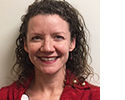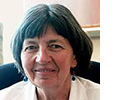1. Walk the walk to build trust with your staff.
 Jess Rivera, Manager, Community Clinics Environmental Services
Jess Rivera, Manager, Community Clinics Environmental Services
Managing 36 Environmental Services technicians spread across multiple U of U Health Community Clinics locations isn’t easy. That’s why manager Jess Rivera has committed herself to earning the respect and trust of her staff. “When I transitioned into a managerial role, I still put on a uniform with my team to do the dirty work,” Rivera says. “Sometimes I worked the night shift; sometimes I worked the day shift; sometimes I showed up on weekends. Working side by side, our conversations are more genuine; they get a sense of who I am, and I get to show them how to put performance standards into action. You have to keep walking that walk to build upon that trust."
“Sometimes I worked the night shift; sometimes I worked the day shift; sometimes I showed up on weekends. Working side by side, our conversations are more genuine; they get a sense of who I am, and I get to show them how to put performance standards into action. You have to keep walking that walk to build upon that trust."
The Vision Summary
How to Define Your Vision
Our system’s best change agents tell us there are four key areas you need to address before starting any improvement effort: Benefit, Team, Patient, Measurement: Ask These Four Questions Before Starting Any Improvement.
2. Define your vision to the team.
 Carissa Christensen, RD, Nutrition Care Services
Carissa Christensen, RD, Nutrition Care Services
Christensen had to figure out how to motivate an entire system to work on a goal everyone could agree was important: reducing obesity. Key to the project’s success was communicating the benefit to patients. “It’s not fair to ask your staff to put forth effort unless it can benefit patients,” Christensen says. “I’ve worked in other health systems where my team and I asked, ‘Why are we headed in this direction?’ I’ve spent my career fighting to get my programs noticed, but I have now learned that patience is truly a virtue, especially if you let your team know that they can contribute to the solution of making a difference on a huge problem."
“It’s not fair to ask your staff to put forth effort unless it can benefit patients.”
3. Create a culture of civility.
 Sue Childress, RN, Director or Nursing, Huntsman Cancer Institute.
Sue Childress, RN, Director or Nursing, Huntsman Cancer Institute.
To fight compassion fatigue in Huntsman Cancer Institute nurses, Childress and her team heard from their staff that civil communications were critical. “We had to create a workplace that had zero tolerance for incivility,” Childress says. “Employees need to know how to clearly communicate expectations and behavior standards . Also, they need to know how to identify the difference between incivility and constructive criticism.”
“We had to create a workplace that had zero tolerance for incivility.”
4. Focus on what’s essential.
 Tracy Farley, RN, Nurse Manager at University Neuropsychiatric Institute
Tracy Farley, RN, Nurse Manager at University Neuropsychiatric Institute
Two seminal experiences inform Farley’s work at UNI: one, his past work with mental health patients, and two, his brother’s 10-year fight against heart failure, which recently culminated in open heart surgery at University of Utah Health. “When we’re receiving health care, we’re particularly critical,” Farley says. “But everything my brother has experienced has exceeded my expectations. It’s reminded me I work with people who are compassionate and kind, who value every single individual. We often forget what is truly essential: making a human connection with patients and seeing them as they are. It’s particularly difficult with patients experiencing altered states or those on medication. But when we see them as a person that makes a big difference.”
Accelerate Editorial Team
To disagree means failing to agree. Synonyms include to contradict, challenge or debate. Synonyms do not also have to include to argue, quarrel, dispute, bicker or clash. Pediatric intensivist Jared Henricksen shares the best path forward when words become clouded with emotion.
Learning to listen is not only a leadership skill—it’s a life skill. Leadership training specialist Jess Burgett shares three practical tips for harnessing the power of listening with intent.
Continually speaking up is one of the most challenging things an employee does, and making it safe to speak up takes consistent supportive leadership. Members of the patient support services team share how to empower employees to highlight issues and provide solutions.
